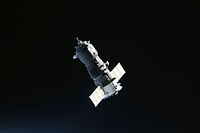
Photo from wikipedia
Abstract The high-energy accelerator-based simulation of both Galactic Cosmic Rays (GCR) and secondary radiation, to which astronauts will be exposed within a spacecraft in deep space, is a very relevant… Click to show full abstract
Abstract The high-energy accelerator-based simulation of both Galactic Cosmic Rays (GCR) and secondary radiation, to which astronauts will be exposed within a spacecraft in deep space, is a very relevant task for the purposes of space radiobiology. In this work, a method of simulating continuous proton, neutron, and π ± -meson spectra within the habitable module of a spacecraft is described. The methods are based on a linear combination of the energy spectra of particles emitted at various angles from three different targets bombarded by a high-energy proton beam. The consecutive irradiation of targets makes it possible to create in a certain volume near the beam a summary field that is similar in characteristics to the nucleon field inside the habitable module exposed to GCR averaged over solar activity.
Journal Title: Radiation Measurements
Year Published: 2017
Link to full text (if available)
Share on Social Media: Sign Up to like & get
recommendations!